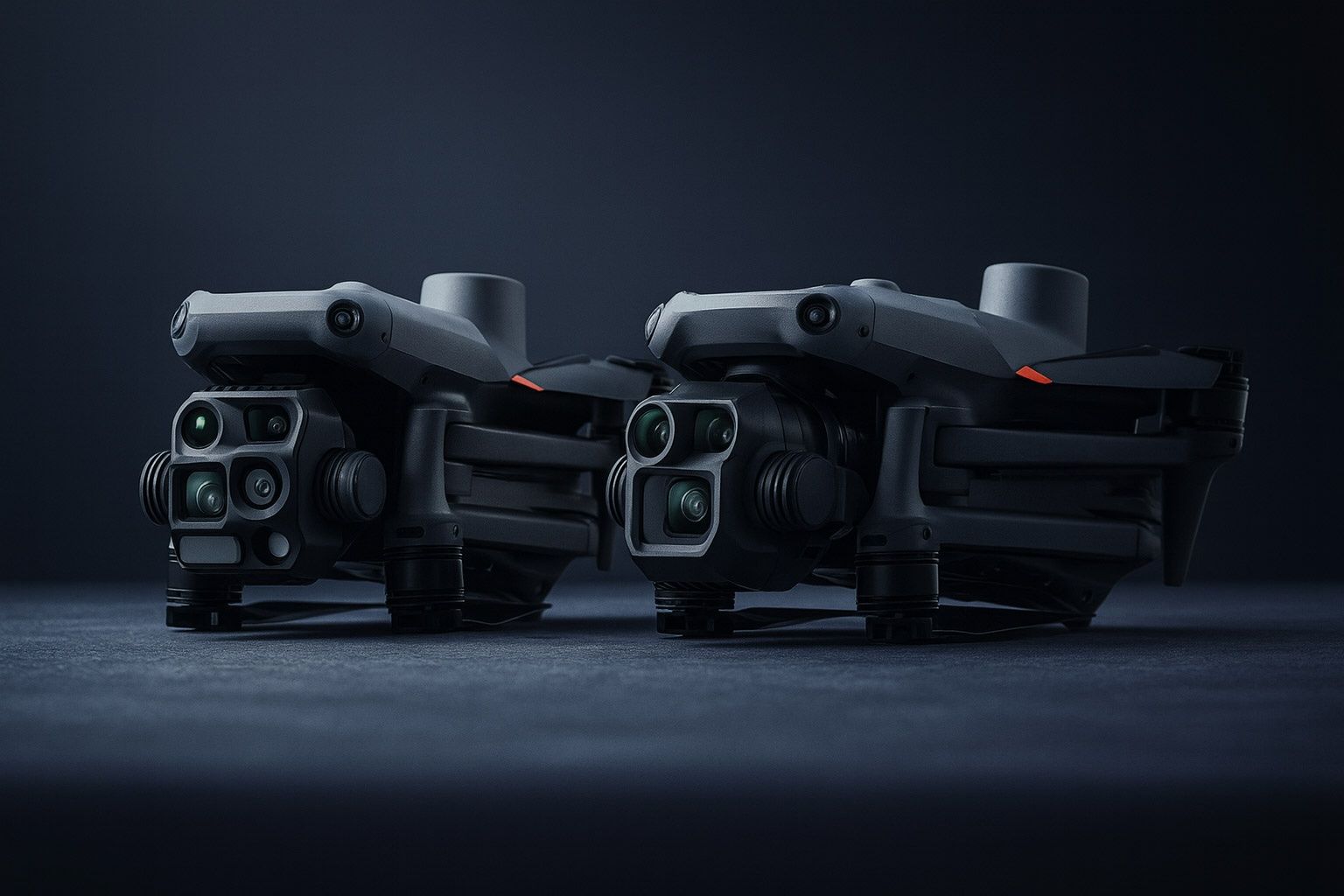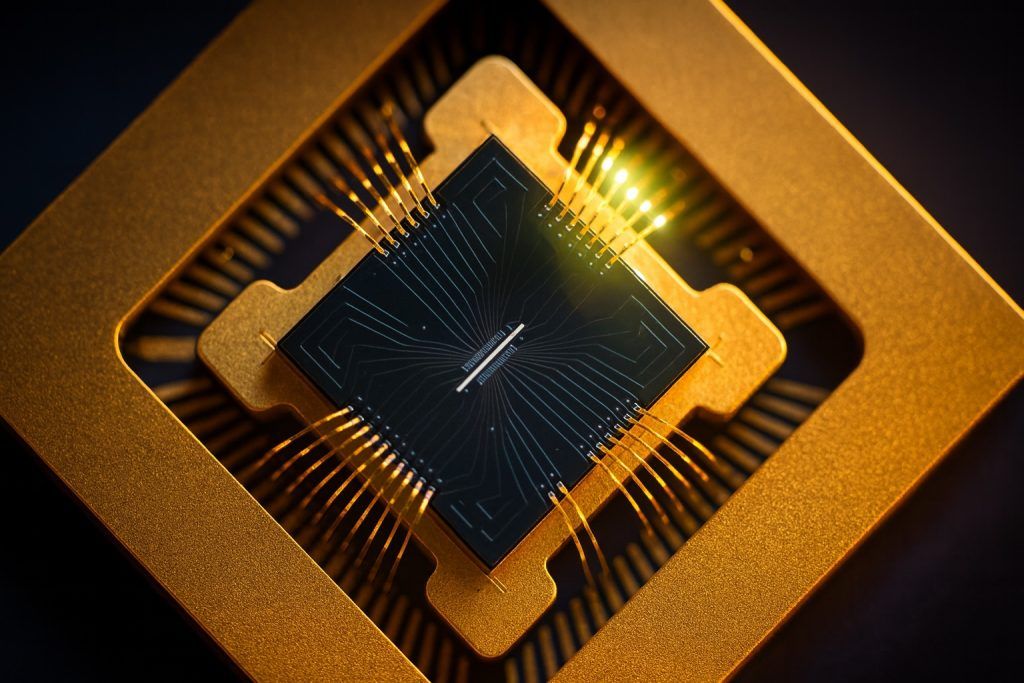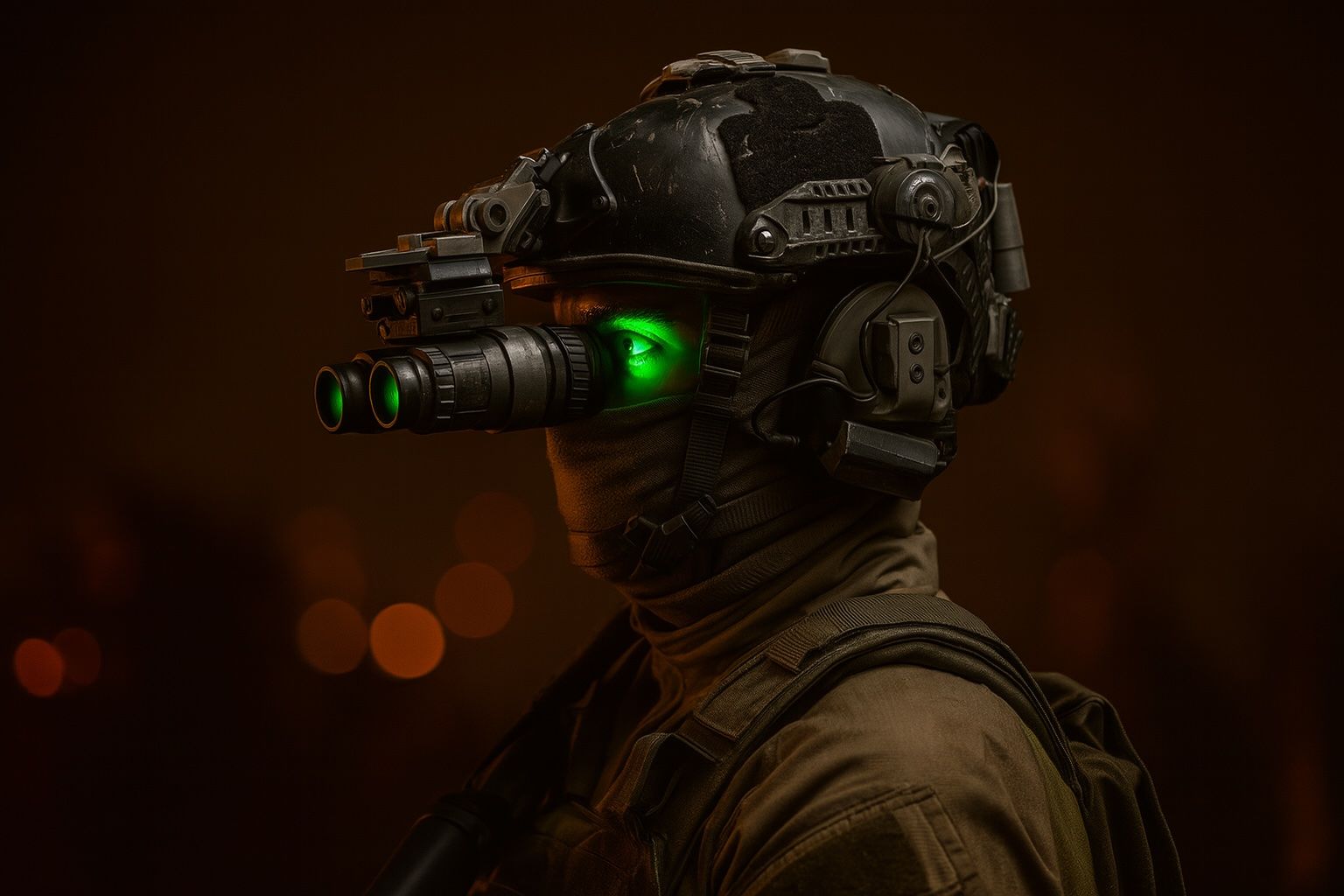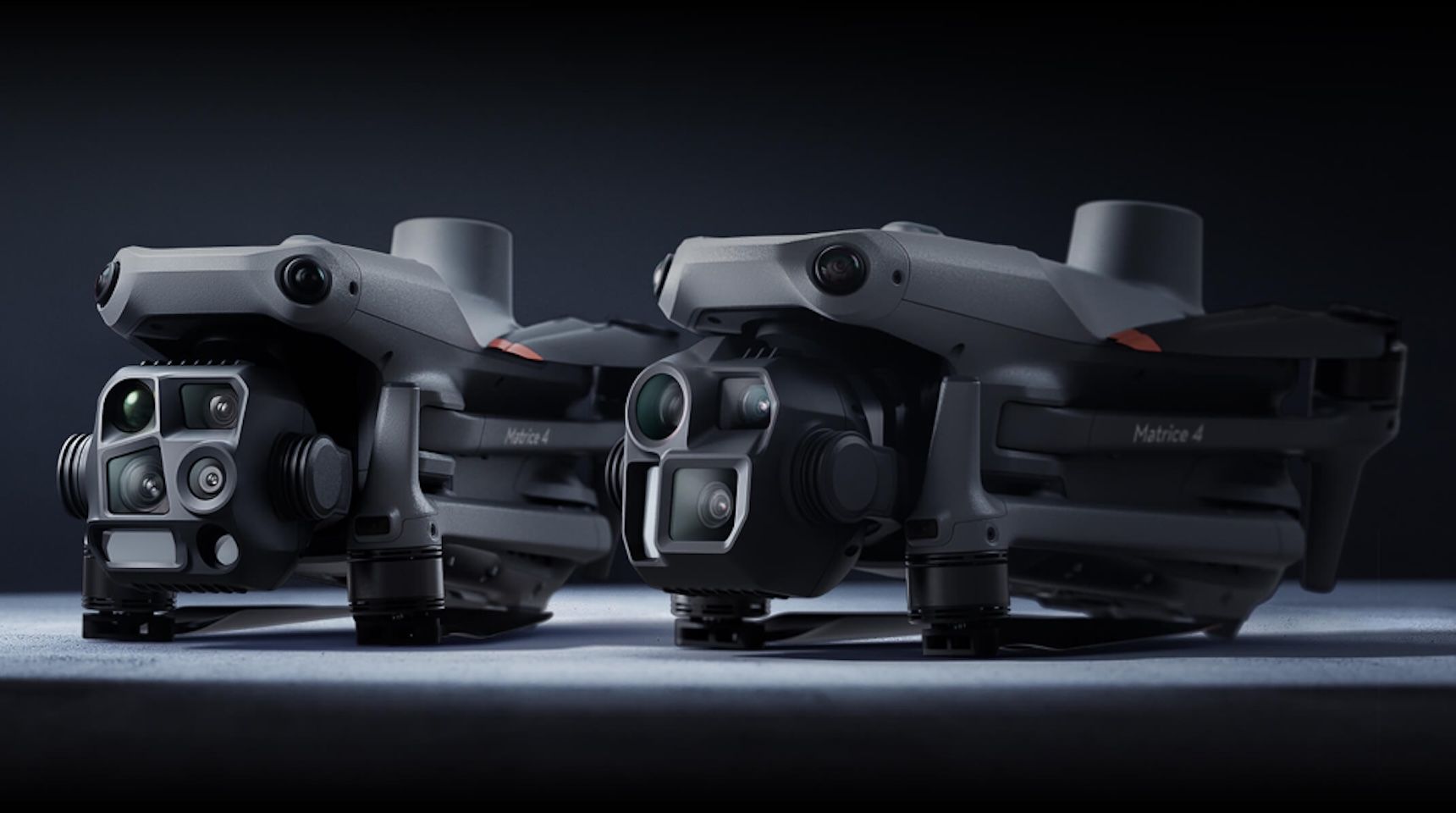- The Matrice 4E and Matrice 4T were released in January 2025, introducing triple-sensor payloads and advanced AI features for enterprise use.
- The Matrice 4E uses a 20 MP 4/3″ wide camera with a mechanical shutter.
- The Matrice 4T uses a 48 MP 1/1.3″ wide camera with no mechanical shutter.
- The Mavic 3E uses a 20 MP Four-Thirds wide camera with a mechanical shutter, while the Mavic 3T uses a 48 MP 1/2″ wide camera with an electronic shutter.
- The Matrice 4E and 4T offer built-in RTK, while the Mavic 3E and 3T rely on optional RTK modules.
- The Matrice 4E/4T can achieve up to 128× hybrid zoom on their tele cameras, roughly 16× optical, beating the Mavic 3T’s 56× hybrid.
- The Matrice 4T adds a 640×512 thermal camera with High-Res 1280×1024 mode and a 53 mm equivalent thermal lens.
- The Matrice 4T includes a near-IR spotlight for night operations, enabling illumination up to about 100 m, while the Mavic 3T has no built-in spotlight.
- Flight times are about 49 minutes for the Matrice 4E/4T and about 45 minutes for the Mavic 3E/3T.
- Portability differs: the Mavic 3E/3T fold to roughly 22×10×9 cm, weigh under 1 kg, and deploy in under 2 minutes, while the Matrice 4 series is non-folding, heavier, and typically requires 5–10 minutes to set up.
In the battle of DJI’s enterprise drones, the new Matrice 4 Series goes head-to-head with the proven Mavic 3 Enterprise Series. In this detailed comparison, we’ll explore the comprehensive specs, strengths, weaknesses, and best use cases of DJI’s Matrice 4E, Matrice 4T, Mavic 3T, and Mavic 3E. These drones are packed with professional features – from high-resolution thermal imaging and RTK precision to multi-sensor payloads – but each model has unique advantages. Recent developments in 2024-2025 (including the Matrice 4’s launch) have raised the bar for aerial operations [1] [2]. Read on for a spec-by-spec breakdown, expert insights, differences between models, and a look at what’s next in DJI’s enterprise lineup.
Comparison Table: Core Specs and Features
To start, here’s a side-by-side look at the core specifications of the Matrice 4E, Matrice 4T, Mavic 3E, and Mavic 3T:
| Feature | DJI Matrice 4E | DJI Matrice 4T | DJI Mavic 3E | DJI Mavic 3T |
|---|---|---|---|---|
| Release Year | 2025 (Jan) [3] | 2025 (Jan) [4] | 2022 (Sept) [5] | 2022 (Sept) [6] |
| Weight (w/ battery) | ~1219 g (1.22 kg) [7] | ~1250 g (approx., slightly more with thermal) [8] | 915 g [9] | 920 g [10] |
| Flight Time (max) | ~49 min (no wind) [11] | ~49 min (identical to 4E) [12] | ~45 min (no wind) [13] | ~45 min (identical to 3E) [14] |
| Max Range (Transmission) | 25 km (FCC); 12 km (CE) [15] [16] | 25 km (FCC); 12 km (CE) [17] [18] | 15 km (FCC); 8 km (CE) [19] | 15 km (FCC); 8 km (CE) [20] |
| Video Link System | O4 Enterprise (1080p @ 30 fps downlink) [21] [22] | O4 Enterprise (1080p @ 30 fps) [23] [24] | O3 Enterprise (1080p @ 30 fps) [25] [26] | O3 Enterprise (1080p @ 30 fps) [27] [28] |
| Wide Camera (main) | 20 MP 4/3″ CMOS, Mechanical Shutter (24 mm equiv.) [29] [30] | 48 MP 1/1.3″ CMOS, Electronic Shutter (24 mm equiv.) [31] [32] | 20 MP 4/3″ CMOS, Mechanical Shutter (24 mm equiv.) [33] | 48 MP 1/2″ CMOS, Electronic Shutter (24 mm equiv.) [34] |
| Medium Tele Camera | 48 MP 1/1.3″ CMOS (3× optical zoom, ~70 mm) [35] [36] | 48 MP 1/1.3″ CMOS (3× optical, ~70 mm) [37] [38] | N/A (no medium tele lens) | N/A |
| Telephoto Camera | 48 MP 1/1.5″ CMOS (7× optical zoom, 168 mm) [39] [40] | 48 MP 1/1.5″ CMOS (7× optical, 168 mm) [41] [42] | 12 MP 1/2″ CMOS (≈7× optical, 162 mm) [43] [44] | 12 MP 1/2″ CMOS (≈7× optical, 162 mm) [45] [46] |
| Max Zoom (Hybrid) | Up to 128× hybrid (approx. 16× optical total) [47] [48] | Up to 128× hybrid (16× optical) [49] [50] | Up to 56× hybrid (7× optical + digital) [51] [52] | Up to 56× hybrid (7× optical + digital) [53] [54] |
| Thermal Camera | None (no thermal sensor) | Yes – 640×512 px @30 Hz, uncooled VOx, 53 mm equiv.; supports 1280×1024 Super-Res mode [55] [56] | None | Yes – 640×512 px @30 Hz, uncooled VOx, 40 mm equiv. [57] [58] |
| Laser Rangefinder | Yes – up to 1,800 m range (±0.2 m + 0.15% accuracy) [59] [60] | Yes – up to 1,800 m range (same as 4E) [61] [62] | No | No |
| Night/Vision Aids | Low-Light Omnidirectional Sensors; No thermal | Low-Light Sensors + IR Spotlight (NIR illuminator up to 100 m) [63] [64] | Basic omnidirectional sensors (no IR light) | Basic sensors (no IR light) |
| RTK Positioning | Built-in RTK (cm-level, GNSS w/ GLONASS when RTK on) [65] [66] | Built-in RTK (same as 4E) [67] [68] | Optional RTK module (attach on top for cm precision) [69] [70] | Optional RTK module (same as 3E) [71] [72] |
| Max Payload | ~200 g via E-Port (e.g. add-on sensors) [73] [74] | ~200 g via E-Port (same) [75] [76] | Limited (small top-port accessories only, e.g. speaker) | Limited (small accessories only) |
| Top Speed (Sport mode) | 21 m/s (≈75 km/h) [77] | 21 m/s (≈75 km/h) [78] | 15 m/s (≈54 km/h) [79] | 15 m/s (≈54 km/h) [80] |
| Wind Resistance | 12 m/s (≈43 km/h) [81] | 12 m/s (≈43 km/h) [82] | 12 m/s (≈43 km/h) [83] | 12 m/s (≈43 km/h) [84] |
| Notable Use Cases | Surveying, Mapping, Construction, Inspection [85] [86] | Public Safety, Emergency Response, Inspection, Night Ops [87] [88] | Mapping (small-scale), Surveying, Inspection [89] [90] | Firefighting, Search & Rescue, Roof/Power Inspections [91] [92] |
Table: Key specifications of the Matrice 4E, Matrice 4T, Mavic 3E, and Mavic 3T. The Matrice 4 series (2025) introduces a triple-sensor payload (quad-sensor on 4T with thermal) and advanced features like a laser rangefinder and O4 transmission, whereas the Mavic 3 series (2022) offers a lighter dual-sensor setup and O3 Enterprise link. Bold entries highlight significant capabilities (e.g., 128× zoom).
Camera Systems and Imaging Capabilities
DJI has equipped these drones with different camera systems tailored to their missions. The Mavic 3 Enterprise series drones carry a lightweight dual-camera setup: a wide-angle camera and a telephoto zoom camera. The Mavic 3E’s wide camera uses a large 20 MP Four-Thirds CMOS with a mechanical shutter for crisp, blur-free mapping photos [93]. In contrast, the Mavic 3T’s wide camera is a 48 MP 1/2″ sensor (no mechanical shutter) optimized for general imaging [94]. Both Mavic models share a 162 mm equivalent tele camera (≈7× optical) for inspections, providing up to 56× hybrid zoom for reading details at a distance [95] [96]. This dual-sensor design keeps the Mavic 3 drones compact and fast-deployable, but it limits their range of focal lengths for imaging [97].
The Matrice 4 Series drones step up the imaging game with a multi-sensor gimbal payload. Both the 4E and 4T carry three different optical cameras: a wide-angle, a medium telephoto, and a telephoto lens [98]. You can seamlessly switch between a 24 mm wide, ~70 mm mid-tele, and 168 mm tele during flight, covering a huge zoom range without swapping drones [99] [100]. The Matrice 4E’s wide camera features the coveted 20 MP 4/3″ sensor and mechanical shutter (shoots images as fast as every 0.5 s) – ideal for rapid mapping and 3D modeling [101]. The Matrice 4T’s wide camera, however, uses a smaller 1/1.3″ 48 MP sensor (f/1.7) [102]. This is still high-resolution, but the trade-off is in low-light performance and the lack of a mechanical shutter, since the 4T is not primarily aimed at mapping (more on that below). Both Matrice models use high-resolution 48 MP sensors for the medium and long tele cameras, yielding greater zoom clarity than the Mavic’s 12 MP tele camera [103] [104]. In fact, the Matrice 4’s tele can achieve up to 128× hybrid zoom (with ~16× combined optical) compared to 56× on the Mavic 3T [105] [106]. As one industry reviewer put it, “Mavic 3T delivers solid mid-range performance but maxes out at 56×… Matrice 4T stretches to 128×…with better optics and more image stability at long range” [107]. This means inspectors can read finer details (like utility pole tags or hairline cracks) from farther away, enhancing safety and efficiency.
Another new addition on the Matrice 4 is the built-in Laser Rangefinder (LRF) on both 4E and 4T models. This LRF can accurately measure distances up to ~1.8 km and even calculate areas or heights by pinpointing multiple points [108] [109]. For example, a pilot can mark a target and instantly get its GPS coordinates and distance – very useful for search & rescue or surveying. The Mavic 3 series has no laser rangefinder, so pilots must estimate distances visually or rely on map telemetry.
Thermal Imaging is a major differentiator between the “E” and “T” variants. The Mavic 3T introduced a 640×512 px thermal camera (13 mm lens, 30 Hz) alongside its visual cameras, which was invaluable for firefighters, police, and industrial inspectors [110] [111]. It allows dual visible-thermal view (split-screen or overlay) with 28× continuous digital zoom on the thermal image [112]. This is sufficient for basic thermal checks – e.g. finding hot spots on a roof or during a quick power line scan – and the M3T provides temperature readouts, color palettes, and isotherm tools for analysis [113]. The Matrice 4T takes enterprise thermal to the next level. It also uses a 640×512 uncooled VOx sensor (similar core specs), but adds a High-Res mode that outputs 1280×1024 px thermal images for greater detail [114] [115]. Essentially, the 4T can micro-scan or composite multiple thermal frames to give four times the thermal resolution of the raw sensor – providing clearer thermal imagery when needed. Additionally, the 4T’s thermal lens is a longer 53 mm equivalent, offering a narrower FOV than the M3T’s ~40 mm lens [116]. This means the Matrice 4T can detect heat signatures from farther distances with greater focus, albeit covering a smaller area per frame. In side-by-side usage, the Matrice’s thermal view is both sharper and can see further, which in practice yields “cleaner, more actionable data” in difficult conditions like smoke, haze, or darkness [117] [118]. For example, in a wildfire or search-and-rescue scenario, the 4T can spot a person or hot spot at greater range, where the M3T’s image might be pixelated at maximum zoom. Both the M3T and 4T support useful thermal features (point/area temperature measurement, high-temp alarms, multiple color palettes, etc.), but the 4T’s clarity and zoom advantage make a big difference for specialized missions [119] [120].
AI, Night Operations and Special Features
Beyond raw camera specs, DJI has infused the Matrice 4 series with advanced AI and night-ops capabilities that set it apart from the Mavic 3 series. Thanks to more powerful onboard processing, the Matrice 4E/4T can perform “smart detection and tracking” of people, vehicles, and vessels in real time [121]. This SmartTrack ability automatically locks onto moving subjects (e.g. a missing person or suspect vehicle) and keeps them centered, even adjusting the zoom as needed [122]. These AI analytics are especially useful during public safety missions, where the drone can aid crews by highlighting targets [123]. The Matrice 4 drones also feature new intelligent flight modes like Cruise Mode (maintain a set course without constant stick input) and PinPoint targets (mark an object to get its location via the LRF) [124]. Such modes reduce pilot workload during lengthy search or survey flights.
Another boost for the Matrice 4T in particular is its design for low-light and night operations. DJI integrated a near-IR (NIR) illuminator “spotlight” on the 4T gimbal – a focused IR beam with a 6° field of view that can light up objects ~100 m away in the dark [125] [126]. This invisible IR light, combined with an IR-cut filter that can be removed from the camera, means the 4T’s cameras can act like night-vision sensors. They can see with the aid of IR illumination, producing clearer grayscale imagery in complete darkness beyond what a normal camera could do [127] [128]. The Mavic 3T does not have any built-in IR spotlight or special night-vision mode – it relies purely on its thermal for darkness or an external visible flashlight attachment. Thus, for night surveillance or search missions, the Matrice 4T offers a huge advantage by combining thermal and low-light visual capabilities. It can, for instance, spot a person with thermal behind a bush, then switch to the starlight camera with IR light to get a clearer identification once up close – all in one flight. As DJI’s enterprise director noted, by equipping drones with AI and night vision like this, “search and rescue teams can save lives faster”, raising operational effectiveness to a new level [129].
It’s worth mentioning that all models have omnidirectional obstacle sensing (to avoid collisions). The Matrice 4 series uses an upgraded set of fisheye stereo vision sensors all around, plus an infrared sensor underneath, to provide 360° obstacle detection even in low-light environments [130]. The Mavic 3E/3T also have full obstacle sensing (they share the same vision system as the consumer Mavic 3, with binocular vision in multiple directions) [131] [132]. In practice, both drones can safely navigate around obstacles, but the Matrice 4’s system is tuned for more reliable avoidance in complex or dim environments [133]. Surprisingly, one thing DJI did not include on the Matrice 4 is a LiDAR scanner for obstacle avoidance – despite some expectations that they might use LiDAR (as seen on smaller models) to enhance detection [134]. The obstacle sensing still largely relies on vision, which works well but can be hindered by fog or darkness. Users on industry forums note this omission and hope future models might include LiDAR for even more robust obstacle detection [135].
Flight Performance and Reliability
In terms of flight performance, both the Matrice 4 and Mavic 3 series boast impressive endurance, though the larger Matrice has a slight edge. Under ideal conditions, the M4E/4T can fly up to 49 minutes on a single charge [136] – just a few minutes more than the Mavic 3E/3T’s advertised 45 minutes max [137]. In real-world missions with payload and wind, actual flight times are lower (typically 25–35 minutes on M3E, and 30–40 minutes on M4E as reported by some users [138] [139]). The Matrice 4’s slightly larger batteries (100 Wh) and efficient design give it a stamina boost, which can be crucial for covering large areas in one go. It also has hot-swappable batteries and advanced battery management – including built-in battery self-heating for cold weather ops (a feature inherited from higher-end Matrice drones) [140] [141]. By contrast, the Mavic 3 uses a single 100 W battery without active heating, meaning it prefers above-freezing conditions. The specified operating temperature range for the M3 series is -10°C to 40°C [142], and the Matrice 4 series is similar in official specs (also -10°C to 40°C) [143]. Unofficially, the Matrice 4 is built with more weather resilience – it has better sealing and can handle a bit of rain or dust, but DJI has not given it an IP rating. Neither the M3E/T nor M4E/T is formally water-resistant, so heavy rain flights are not advised [144] [145]. For all-weather tasks, the larger Matrice 30/350 drones (IP55) are still the go-to. The lack of official ingress protection on M4 indicates it’s a “fair-weather” enterprise drone similar to the Mavic in that regard, albeit one “built for field abuse” a bit more with sturdy design [146] [147].
When it comes to speed and maneuverability, the Matrice 4 is notably more powerful. It can sprint at about 21 m/s (75 km/h) in Sport mode [148], whereas the Mavic 3 Enterprise tops out around 15 m/s (54 km/h) [149]. This higher thrust also helps the Matrice 4 fight wind better when carrying its payload – both series are rated for ~12 m/s wind resistance (about 43 km/h) [150], but the heavier Matrice will be more stable in gusts. Pilots report that the Matrice 4 feels rock-solid in the air even on longer missions, thanks to its robust build and higher inertia [151] [152]. The Mavic 3 is very nimble and efficient for quick missions, but can get buffeted more in strong winds or when zooming the camera at extreme range (any slight drift is magnified when fully zoomed) [153] [154]. Overall, for quick spot tasks or back-to-back hops, the Mavic’s agility is great; for long, high-precision flights, the Matrice offers more confidence and “margin” in performance [155] [156].
Both drone series use DJI’s latest digital transmission systems for control and video feed. The Matrice 4 comes with the new O4 Enterprise system, boasting up to 25 km range (FCC) or 12 km (CE) with a 1080p live feed [157] [158]. The Mavic 3 Enterprise uses O3 Enterprise, up to 15 km (FCC) / 8 km (CE) range with 1080p feed [159] [160]. In practice, both provide a very clear and low-latency feed within typical mission ranges (1–5 km), but O4 offers stronger signal redundancy and penetration in interference-heavy areas. This means the Matrice 4 can maintain link quality in urban environments or behind obstacles a bit better, and has more range headroom (useful for beyond-visual-line-of-sight operations or when using as a tethered drone etc.). Additionally, the M4 controllers support DJI’s 4G dongle for cellular link as backup [161] (should an operation require it), and DJI has emphasized improved security in the new drones – e.g. Local Data Mode (no internet) and completed cybersecurity audits, given rising concerns about drone data safety [162].
RTK and Mapping Precision
For surveyors and mappers, RTK (Real-Time Kinematic) capability is a deciding factor. The Mavic 3E was notable for introducing an optional RTK module on a small drone – a snap-on top accessory that enables centimeter-level positioning accuracy for mapping missions [163] [164]. With RTK activated, the M3E can capture ground control–grade aerial maps without needing many ground control points, thanks to precise geotagging and the mechanical shutter that minimizes distortion [165] [166]. The Mavic 3T also accepts the RTK module, which can improve the geolocation of its thermal imagery, but since its main camera lacks a mechanical shutter and uses a smaller sensor, it’s not ideal for high-accuracy photogrammetry (rolling shutter can introduce slight warping) [167]. Many experts consider the M3T’s RTK more for aligning thermal maps or ensuring repeatable camera positioning (e.g. inspecting the exact same spot periodically) rather than precision mapping. In fact, one mapping professional noted “the 4T isn’t for mapping… the RTK [on 4T] allows for repeat observations… The 4E is for mapping, and has a proper camera (not much different than the 3E)” [168] [169]. This highlights that Matrice 4E is the true successor for aerial survey work.
DJI clearly designed the Matrice 4E with mapping efficiency in mind. It comes standard with RTK built-in – no extra module needed [170] – and it leverages that by offering fast 0.5 s interval shooting, 5-directional oblique imaging, and “Smart 3D Capture” automation [171] [172]. The 5-directional capture means the gimbal can tilt automatically to capture oblique photos (forward, back, left, right, plus nadir) as it flies, covering facades of structures in one mission [173]. Previously, operators would have to fly multiple separate missions or manually tilt the camera to get oblique angles for 3D models. The Matrice 4 can do it all in one go, significantly speeding up 3D modeling of buildings or terrain [174]. Its Smart 3D Capture can even generate a rough preview model on the remote controller in real-time after a mapping flight [175]. This gives surveyors immediate quality feedback and even auto-generates precise flight routes for follow-up mapping of complex structures [176]. These are big productivity gains. In essence, the Matrice 4E (and 4T can also leverage these for non-thermal mapping) brings the kind of efficiency one would get from a larger mapping drone or multiple flights, into a single compact drone. One DJI enterprise insider called the Matrice 4 series “a well-balanced solution for aerial surveying, combining efficiency, accuracy, and portability” [177], marking a step change in geospatial operations at this scale.
It’s worth noting the Matrice 4T also supports RTK for its positioning, which is useful for alignment and precise hovering (e.g. holding exactly on a GPS coordinate while monitoring a target) [178]. However, as experts point out, even if you attach RTK to the 4T, it “can’t guarantee” the final map accuracy that the 4E delivers [179]. The 4T’s wide camera simply isn’t built for survey-grade orthophotos. Therefore, organizations focused on surveying, construction mapping, or mining will find the Matrice 4E to be an ideal choice – effectively letting them retire older workhorses like the Phantom 4 RTK, as one user suggested [180]. Meanwhile, the 4T will appeal more to those needing thermal and inspection capabilities with occasional mapping of less demanding accuracy.
Portability and Deployment Factors
Despite their feature differences, the biggest practical consideration in this comparison might be deployment and ease of use in the field. The Mavic 3E/T are ultra-portable – they fold up compactly (roughly 22×10×9 cm folded) and weigh under 1 kg [181] [182]. A single person can easily carry a Mavic kit in a backpack and have it ready to fly in under 2 minutes [183] [184]. This quick setup is invaluable for first responders, police, or any team that needs to launch fast on the go. It’s literally a “grab-and-go” drone; unfold the arms, power on, and take off.
The Matrice 4E/T, while still relatively compact for its capabilities, require a bit more TLC to deploy. The Matrice 4 does not have folding arms – it comes in a protective case, and its sturdier airframe (about 1.2 m diagonal span) needs a bit more space to store and launch [185] [186]. Setting up a Matrice 4 might take about 5–10 minutes: you’ll need to attach the props (which are larger 10.8″ foldable props), possibly attach battery or accessories, and do pre-flight checks [187] [188]. It’s still far quicker than the older Matrice 300 series, but compared to the Mavic it’s a slower process. The drone is designed to be transported in a hard case or vehicle trunk, not so much a small backpack [189] [190]. Moreover, operations with the Matrice 4 often benefit from a two-person crew: one pilot and one camera operator or spotter, especially in complex missions [191] [192]. It’s certainly possible for a single skilled pilot to run it solo (just as one can solo pilot an M300), but to exploit its full sensor suite and maintain visual line-of-sight, many organizations will use an extra set of hands.
In short, if your work involves rapid deployments, multiple sites per day, or confined spaces, the Mavic 3E/T’s small size is a huge advantage. For example, a roofing inspector or traffic police unit can keep a Mavic in the car and deploy it virtually anywhere within moments. A Matrice 4, by contrast, might need a flat open area to take off from and is less discreet when deployed (larger size and louder). However, when you need the advanced capabilities and can plan a mission, the Matrice 4’s additional setup is justified. As one comparison noted, the Mavic is “solo-friendly” whereas the Matrice is “mission-ready” but benefits from a team approach [193] [194]. Think of it like this: the Mavic 3 Enterprise is a quick responder for everyday tasks, while the Matrice 4 is a heavy scout for planned operations that demand superior tech.
Strengths and Weaknesses Breakdown
Let’s summarize the key strengths, weaknesses, and ideal use cases for each model in turn:
Matrice 4E – Strengths & Use Cases
- High-Precision Mapping: Equipped with a 20 MP 4/3″ mechanical shutter camera and built-in RTK, the 4E can capture survey-grade maps and 3D models with speed and accuracy [195] [196]. It excels in construction surveying, urban mapping, and volumetric measurements (mining, stockpiles).
- Multi-Angle Imaging: Its triple-camera array (wide, medium, tele) plus automated oblique capture allows comprehensive imaging of structures in one flight [197]. This makes the 4E perfect for infrastructure inspection (bridges, cell towers) where you need both wide context and zoomed details.
- Enhanced Flight Performance: Slightly longer flight time (~49 min) and robust handling give it an edge for large-area missions. Pilots can cover up to 35 km in one flight under ideal conditions [198], enabling efficient corridor mapping (roads, pipelines).
- Smart Features: AI object detection, laser rangefinder measurements, and advanced mission planning (waypoints, Smart 3D) improve operational efficiency and safety [199] [200]. These features shine in scenarios like search operations or precision inspection, where real-time data is critical.
Matrice 4E – Weaknesses: It lacks a thermal camera, so it’s not suitable for tasks requiring heat detection (e.g. firefighting or solar farm inspections at night). It also has no official IP rating, limiting use in bad weather [201]. The larger form factor and higher cost (several times the price of a Mavic 3E) mean it’s an investment typically justified by intensive professional use. It’s overkill for simple jobs where a smaller drone can suffice.
Matrice 4T – Strengths & Use Cases
- Thermal & Night Operations: With its integrated radiometric thermal camera (640×512 with high-res mode) and IR illuminator, the 4T is a powerhouse for public safety, firefighting, and search & rescue [202] [203]. It can find people in darkness or smoke and provide both thermal and low-light visual feeds – critical for emergency responders.
- Versatile Inspection Tool: The combination of wide, medium, tele cameras plus thermal means the 4T can tackle almost any inspection scenario. For example, in power line inspections, it can zoom in optically on hardware, then check for hot connections via thermal, all in one flight. Its 128× zoom and laser rangefinder let inspectors examine distant structures safely from the ground [204] [205].
- Situational Awareness for Policing & Security: The 4T is well-suited for police units and security patrols. It provides real-time tracking of suspects or vehicles via AI SmartTrack [206], and the thermal helps in pursuits at night or finding hidden objects (e.g. tossed evidence) in fields. Many public safety agencies will appreciate that this drone can effectively serve as an “eye in the sky” day or night.
- Industrial Maintenance: In sectors like oil & gas or chemical plants, the 4T can detect thermal anomalies (leaks, overheating equipment) and also inspect infrastructure visually. Its rugged design and long flight time allow covering large facilities with fewer battery swaps.
Matrice 4T – Weaknesses: Like the 4E, it’s not water-proof – a notable drawback for a drone that might be needed in rainy emergency scenes. It also trades the superior mapping camera for the thermal; for purely mapping jobs, the 4T is less optimal (the smaller sensor and rolling shutter mean lower photogrammetry accuracy) [207]. Some users lament DJI didn’t make a single model that combines the big camera and thermal together [208] – meaning organizations might need to buy both 4E and 4T to cover all bases. The Matrice 4T is also expensive (its advanced payload pushes it into the ~$10k+ range), which can be a barrier for smaller departments. And compared to the Matrice 30T (which has similar thermal but is weather-hardened), the 4T is less all-weather capable, so agencies must plan around that.
Mavic 3E – Strengths & Use Cases
- Portability & Quick Deployment: The M3E’s greatest strength is its small size and agility. It can be carried anywhere and launched in moments [209]. This makes it ideal for tasks like accident site mapping, quick surveys of small areas, or on-demand inspection where time is of the essence.
- Affordable Mapping Solution: With its 20 MP mechanical shutter and RTK option, the Mavic 3E brings serious mapping ability in a compact form [210] [211]. It’s great for surveying modest-sized projects (buildings, stockpile yards, farms) where a Phantom 4 RTK might have been used previously. It offers centimeter-level accuracy without a huge drone platform.
- Generalist Tool for Businesses: Many commercial drone service providers favor the M3E for its balance of capability and cost. It can perform daytime inspections (with 56× zoom to check details) and create orthomosaics or 3D models reliably. Use cases include construction progress tracking, roof inspections, and accident reconstruction for public safety, where the resolution and accuracy are sufficient.
- Longest Flight in its Class: 45 minutes of flight time on such a small drone is class-leading in the sub-1 kg category [212]. This allows the M3E to cover up to 2 km² mapping in one flight, under good conditions – boosting efficiency for larger jobs, albeit not to the extent of the Matrice 4E’s multi-angle prowess.
Mavic 3E – Weaknesses: The M3E lacks any thermal or night vision capability, limiting it to daylight and visual-spectrum missions. Its range and signal are a bit less robust than the Matrice’s (O3 vs O4), though still ample for most cases [213] [214]. The small size, while great for portability, means it’s more affected by wind and has no redundancy (e.g., it uses a single battery and single downward gimbal – no backup if something fails). Also, the lack of an integrated zoom lens (it has a separate tele camera with only 12 MP) means that extreme zoom images are lower resolution and quality than what the Matrice 4’s 48 MP tele can deliver. Finally, while cheaper than a Matrice, the M3E is still a few thousand dollars; operators needing just basic mapping might find a Phantom 4 RTK (with similar camera) at lower cost, though they’d sacrifice portability and newer features.
Mavic 3T – Strengths & Use Cases
- Compact Thermal Capability: The M3T’s standout strength is packing a thermal imager into a mini-sized drone. For firefighters, inspectors, or agricultural users on a tighter budget, the M3T offers the ability to see heat signatures (like solar panel hotspots, search for people, detect wildlife, etc.) without the cost and complexity of a larger drone. It’s excellent for quick thermal inspections – e.g., a rooftop solar installer scanning panels for defects, or HVAC technicians checking building heat leaks.
- Dual-Vision Flexibility: The drone’s ability to show side-by-side thermal and visual zoom feed (up to 28× continuous) is very handy [215]. For example, during a nighttime security patrol, one can use thermal to spot an intruder in the dark and the zoom camera to identify details, all on one controller screen. This versatility in a small package is a big plus for public safety departments that cannot field larger UAVs.
- Ease of Use and Deployment: Like the M3E, the Mavic 3T is ultra-portable and can be deployed by a single operator almost anywhere. This means quick reaction for emergency calls – many fire departments keep an M3T ready to launch for structure fires or missing person calls, where every minute counts. It can be flown even in tight urban areas or through doorways (in manual mode) if needed, where larger drones simply couldn’t go.
- Lower Cost Entry to Thermal Drones: The M3T, while pricier than the 3E, is still significantly cheaper than a Matrice 30T or 4T. This opens the door for smaller agencies or companies to start using thermal imaging. They can achieve a lot of thermal tasks “good enough” with the M3T before deciding to upgrade to something like a Matrice. For routine tasks like power pole checks or finding livestock at night on a farm, the M3T gets the job done efficiently.
Mavic 3T – Weaknesses: The thermal sensor, though decent, is still 640×512 resolution – fine for many uses, but it cannot match the clarity of higher-end systems (and the M3T lacks the high-res mode of the 4T) [216] [217]. Its wide camera’s rolling shutter also means it isn’t suited for precision mapping, so it’s not a dual-purpose mapping drone like the 3E. In windy or long-range scenarios, the M3T’s light weight can make it challenging to get stable zoomed footage compared to a heavier platform – image stabilization has limits when the drone is being buffeted. Also, no spotlight or speaker comes built-in; although one can attach a small speaker for loud-hailing, the volume and range are limited. Another weakness is the lack of redundancy: with only one downward gimbal carrying both visible and thermal cameras, if that gimbal fails you lose both feeds (whereas larger drones often have separate payloads). Lastly, like the 3E, it’s not weatherproof and has to avoid rain or excessive dust, which sometimes is exactly when thermal drones are needed (e.g., rainy night search). Operators must plan missions accordingly or use protective measures.
Expert Opinions and Industry Insights
Industry experts and early adopters have noted that the Matrice 4 series represents a significant leap in DJI’s enterprise offerings, essentially “a powerful new upgrade that effectively replaces the Mavic 3 Enterprise series” as one commercial drone distributor observed [218]. The consensus is that DJI has merged the portability of the Mavic line with the intelligence of the Matrice line. Drone professionals at DroneDJ even remarked that the Matrice 4 is basically the Mavic Enterprise with a new name – “using ‘Matrice’ instead of ‘Mavic’ clarifies that Mavic is consumer and Matrice is for enterprise” [219]. Indeed, the Matrice 4’s body is described as strikingly similar to the Mavic 3, just with an RTK module on top and a larger multi-sensor payload on the front [220]. This blending of lines was intentional by DJI to eliminate confusion and solidify the Matrice brand for all professional drones.
Early field reactions have been very positive about the Matrice 4T’s advantages over the Mavic 3T. For example, testers in public safety highlighted the noticeably improved thermal detail and zoom. One law enforcement user noted “there’s a measurable improvement in that 4T thermal displayed resolution… and more range” [221]. The ability to maintain standoff distance is a big deal for police and utility inspectors alike. At the same time, some mappers who invested in the Matrice 4E are thrilled to have a modern replacement for older survey drones: “I’m finally trashing my P4 RTK” one surveyor quipped, after seeing the 4E’s mapping output [222]. The 4E’s adoption indicates DJI listened to the photogrammetry community’s needs for a faster, smarter mapping tool.
However, professionals also pointed out certain gaps and wishes. A frequent comment is frustration that DJI did not combine the 4E and 4T into one model with both the best camera and thermal. “I would have loved seeing a single model that did both jobs… maybe next time,” said one enterprise user, reflecting a desire for one drone that has it all [223]. This shows that as advanced as these drones are, users are always looking for even more integration to save costs and complexity. Additionally, some enterprise pilots mention that while the Matrice 4 is highly capable, the accessories ecosystem and support needs to catch up. For instance, the charging hub for the Matrice 4 batteries charges one battery at a time, which a few operators felt was a bottleneck for continuous operations (they expected a more “enterprise-grade” simultaneous charging solution) [224] [225]. DJI may address such feedback in future firmware or accessory updates.
In terms of industrial impact, many experts see the Matrice 4 series as raising the standards for what a compact enterprise drone can do. Drone Nerds, a DJI partner, called the M4 series “a significant advancement in drone technology, offering intelligent, versatile, and reliable solutions… poised to become indispensable tools” across industries from public safety to construction [226]. That sentiment is echoed by enterprise users who value the AI and sensing improvements. The bottom line from expert reviews: the Mavic 3 Enterprise models remain excellent workhorses for many routine jobs due to their simplicity and cost, but the Matrice 4T/4E set a new benchmark for capability in the field. They bring features previously found only in large $20k+ systems down into a midsize drone that more teams can deploy.
Future Outlook: Upcoming DJI Enterprise Drones
Looking ahead, DJI’s enterprise drone lineup is expected to continue evolving rapidly. The release of the Matrice 4 series in early 2025 hints at a convergence of product lines – we likely won’t see a “Mavic 4 Enterprise” in name, because DJI has pivoted to using the Matrice branding for even relatively small enterprise drones [227]. Instead, future portable enterprise models will probably build on the Matrice 4 platform. We may see, for example, a Matrice 4 with different payload options or specialized sensors. One possibility is a multispectral version for precision agriculture and environmental monitoring, akin to the Mavic 3M (Multispectral) that was launched in 2022 for crop analysis. Given DJI’s pattern, a “Matrice 4M” or similar could integrate multispectral cameras for surveyors and agronomists – though a recent rumor suggests DJI might shift strategy or hold off on a dedicated multispectral model [228]. Still, the Matrice 4’s modular payload port (E-Port) leaves room for third-party sensors up to 200 g, so partners could develop plugins like gas detectors or hyperspectral cameras to attach underneath, expanding its uses.
Another anticipated development is in the heavy-lift and long-endurance category. Rumors in 2024 pointed to a drone code-named Matrice 400A, which is said to be a heavy-lift platform targeting ~10 kg payload capacity [229] [230]. This would be a different beast than the M4 or Mavic series – more of a successor to DJI’s Matrice 600 Pro for carrying large sensors or multiple payloads. The leaked specs for the Matrice 400A indicate massive batteries (nearly 1000 Wh) and potentially around 40–50 minutes of flight with a heavy payload [231]. If it materializes, the Matrice 400A could revolutionize tasks like LiDAR mapping, cargo delivery, or multi-camera broadcasting. It’s expected to be in a class of its own, not directly replacing the Matrice 350 RTK but rather augmenting DJI’s range for enterprise users needing extra lift [232] [233].
Meanwhile, DJI continues to support and upgrade its current enterprise models. In 2024, the Matrice 350 RTK (released mid-2023) saw firmware and software updates improving its mission planning and safety features [234] [235]. DJI also introduced new enterprise accessories like the Zenmuse L2 LiDAR and payload drop systems. For the Matrice 4 series specifically, DJI announced two new accessories alongside it: the AL1 Spotlight and AS1 Speaker [236]. These add-ons, releasing in 2025, will further enhance the 4E/4T for search-and-rescue (lighting up scenes at night, broadcasting voice messages to crowds or survivors). We expect more add-on modules to roll out, given the Matrice 4’s focus on being a Swiss-army knife drone. Additionally, third-party companies are stepping in – for instance, AVSS and ParaZero have developed drone parachute recovery systems for the Matrice 4 to improve safety over people [237]. Such a parachute can automatically deploy if the drone fails, a feature that might help the Matrice 4 meet aviation regulations for flight over populated areas.
Finally, it’s impossible to ignore the broader context: regulatory changes and competition could shape DJI’s next moves. With government bans on Chinese-made drones being discussed in the US and other countries [238], DJI may accelerate innovation in autonomous features (to reduce dependence on remote pilots) and data security. They have already emphasized local data modes and security audits to address these concerns [239]. On the competition front, rivals like Autel, Parrot, and Skydio are also pushing enterprise drone tech (e.g., Skydio’s autonomy or Autel’s 6K thermal). DJI’s anticipated responses could include further AI enhancements, better interoperability (e.g., with Drone-in-a-Box stations), and perhaps new drone platforms that defy categories.
In summary, DJI’s enterprise drone lineup in 2025 is more dynamic than ever. The Matrice 4E and 4T are cutting-edge tools setting a new standard for mid-size drones, effectively bridging the gap between small foldable UAVs and large industrial rigs. The Mavic 3E and 3T remain relevant as cost-effective, quick-deploy drones for many everyday professional tasks. Choosing the right model comes down to your specific use case: mapping and modeling – lean 4E or 3E; thermal public safety – 4T if budget allows, or 3T for simpler needs [240]. And for those with diverse mission requirements, a combination might be ideal (many agencies pair a Matrice 4T for heavy-duty missions with a Mavic 3E/T for backup or rapid response). With new DJI innovations on the horizon and an active ecosystem of accessories, enterprise users can expect their drone capabilities to keep soaring. As one expert aptly put it, “It’s not just about specs – it’s about working faster, safer, and more confidently in the field” [241] [242], and DJI’s evolving drone lineup is firmly aimed at that target.
Sources:
- DJI Enterprise Product Pages and Specs [243] [244] [245] [246]
- DJI Support and Manuals [247] [248]
- Enterprise Drone Reviews and Blogs (Drone Nerds, DrDrone, Dronefly) [249] [250] [251] [252]
- DroneDJ News Coverage [253] [254]
- DJI Enterprise Insights & Press Releases [255] [256]
- User and Expert Commentary (Reddit UAVmapping thread) [257] [258]
- Industry Rumors and Updates [259] [260]
References
1. enterprise.dronenerds.com, 2. dronedj.com, 3. www.videolinea.com, 4. www.videolinea.com, 5. enterprise.dji.com, 6. enterprise.dji.com, 7. loyaltydrones.com, 8. www.dronefly.com, 9. enterprise.dji.com, 10. enterprise.dji.com, 11. enterprise.dji.com, 12. enterprise.dji.com, 13. enterprise.dji.com, 14. enterprise.dji.com, 15. enterprise.dji.com, 16. enterprise.dji.com, 17. enterprise.dji.com, 18. enterprise.dji.com, 19. www.dji.com, 20. www.dji.com, 21. enterprise.dji.com, 22. enterprise.dji.com, 23. enterprise.dji.com, 24. enterprise.dji.com, 25. www.dji.com, 26. www.dji.com, 27. www.dji.com, 28. www.dji.com, 29. dronedj.com, 30. enterprise.dronenerds.com, 31. dronedj.com, 32. enterprise.dronenerds.com, 33. www.dji.com, 34. www.dji.com, 35. dronedj.com, 36. drdrone.com, 37. dronedj.com, 38. drdrone.com, 39. dronedj.com, 40. drdrone.com, 41. dronedj.com, 42. drdrone.com, 43. enterprise.dji.com, 44. enterprise.dji.com, 45. enterprise.dji.com, 46. enterprise.dji.com, 47. www.dronefly.com, 48. www.dronefly.com, 49. www.dronefly.com, 50. www.dronefly.com, 51. enterprise.dji.com, 52. www.dronefly.com, 53. enterprise.dji.com, 54. www.dronefly.com, 55. enterprise.dronenerds.com, 56. drdrone.com, 57. enterprise.dji.com, 58. drdrone.com, 59. enterprise.dronenerds.com, 60. enterprise.dronenerds.com, 61. enterprise.dronenerds.com, 62. drdrone.com, 63. enterprise.dronenerds.com, 64. drdrone.com, 65. drdrone.com, 66. enterprise.dji.com, 67. drdrone.com, 68. enterprise.dji.com, 69. enterprise.dji.com, 70. drdrone.com, 71. enterprise.dji.com, 72. drdrone.com, 73. enterprise.dji.com, 74. loyaltydrones.com, 75. enterprise.dji.com, 76. loyaltydrones.com, 77. drdrone.com, 78. drdrone.com, 79. drdrone.com, 80. drdrone.com, 81. drdrone.com, 82. drdrone.com, 83. drdrone.com, 84. drdrone.com, 85. enterprise.dji.com, 86. www.reddit.com, 87. enterprise.dji.com, 88. www.reddit.com, 89. enterprise.dji.com, 90. www.dji.com, 91. enterprise.dji.com, 92. www.dji.com, 93. www.dji.com, 94. www.dji.com, 95. enterprise.dji.com, 96. www.dronefly.com, 97. www.dronefly.com, 98. dronedj.com, 99. dronedj.com, 100. www.dronefly.com, 101. dronedj.com, 102. dronedj.com, 103. enterprise.dronenerds.com, 104. drdrone.com, 105. www.dronefly.com, 106. www.dronefly.com, 107. www.dronefly.com, 108. enterprise.dronenerds.com, 109. enterprise.dronenerds.com, 110. enterprise.dji.com, 111. drdrone.com, 112. drdrone.com, 113. drdrone.com, 114. www.reddit.com, 115. drdrone.com, 116. drdrone.com, 117. www.dronefly.com, 118. www.dronefly.com, 119. www.dronefly.com, 120. www.dronefly.com, 121. enterprise.dronenerds.com, 122. enterprise.dronenerds.com, 123. enterprise.dronenerds.com, 124. enterprise.dronenerds.com, 125. enterprise.dronenerds.com, 126. drdrone.com, 127. www.reddit.com, 128. drdrone.com, 129. dronedj.com, 130. enterprise.dronenerds.com, 131. enterprise.dji.com, 132. enterprise.dji.com, 133. enterprise.dronenerds.com, 134. www.reddit.com, 135. www.reddit.com, 136. enterprise.dji.com, 137. enterprise.dji.com, 138. www.reddit.com, 139. www.reddit.com, 140. www.dronefly.com, 141. www.dronefly.com, 142. enterprise.dji.com, 143. enterprise.dji.com, 144. drdrone.com, 145. drdrone.com, 146. www.dronefly.com, 147. www.dronefly.com, 148. drdrone.com, 149. drdrone.com, 150. drdrone.com, 151. www.dronefly.com, 152. www.dronefly.com, 153. www.dronefly.com, 154. www.dronefly.com, 155. www.dronefly.com, 156. www.dronefly.com, 157. enterprise.dji.com, 158. enterprise.dji.com, 159. www.dji.com, 160. www.dji.com, 161. enterprise.dji.com, 162. dronedj.com, 163. enterprise.dji.com, 164. www.dji.com, 165. enterprise.dji.com, 166. www.dji.com, 167. www.reddit.com, 168. www.reddit.com, 169. www.reddit.com, 170. drdrone.com, 171. www.reddit.com, 172. enterprise.dronenerds.com, 173. enterprise.dronenerds.com, 174. enterprise.dronenerds.com, 175. www.reddit.com, 176. www.reddit.com, 177. enterprise-insights.dji.com, 178. www.reddit.com, 179. www.reddit.com, 180. www.reddit.com, 181. enterprise.dji.com, 182. enterprise.dji.com, 183. www.dronefly.com, 184. www.dronefly.com, 185. www.dronefly.com, 186. www.dronefly.com, 187. www.dronefly.com, 188. www.dronefly.com, 189. www.dronefly.com, 190. www.dronefly.com, 191. www.dronefly.com, 192. www.dronefly.com, 193. www.dronefly.com, 194. www.dronefly.com, 195. dronedj.com, 196. drdrone.com, 197. enterprise.dronenerds.com, 198. enterprise.dji.com, 199. enterprise.dronenerds.com, 200. www.reddit.com, 201. drdrone.com, 202. enterprise.dji.com, 203. www.reddit.com, 204. www.dronefly.com, 205. enterprise.dronenerds.com, 206. enterprise.dronenerds.com, 207. www.reddit.com, 208. www.reddit.com, 209. www.dronefly.com, 210. enterprise.dji.com, 211. www.dji.com, 212. enterprise.dji.com, 213. www.dji.com, 214. enterprise.dji.com, 215. drdrone.com, 216. drdrone.com, 217. drdrone.com, 218. drdrone.com, 219. dronedj.com, 220. dronedj.com, 221. www.facebook.com, 222. www.reddit.com, 223. www.reddit.com, 224. www.reddit.com, 225. www.reddit.com, 226. enterprise.dronenerds.com, 227. dronedj.com, 228. www.facebook.com, 229. loyaltydrones.com, 230. loyaltydrones.com, 231. loyaltydrones.com, 232. loyaltydrones.com, 233. loyaltydrones.com, 234. loyaltydrones.com, 235. loyaltydrones.com, 236. dronedj.com, 237. www.stocktitan.net, 238. dronedj.com, 239. dronedj.com, 240. www.dronefly.com, 241. www.dronefly.com, 242. www.dronefly.com, 243. enterprise.dji.com, 244. enterprise.dji.com, 245. enterprise.dji.com, 246. enterprise.dji.com, 247. www.dji.com, 248. enterprise.dji.com, 249. enterprise.dronenerds.com, 250. drdrone.com, 251. www.dronefly.com, 252. www.dronefly.com, 253. dronedj.com, 254. dronedj.com, 255. enterprise.dronenerds.com, 256. www.reddit.com, 257. www.reddit.com, 258. www.reddit.com, 259. loyaltydrones.com, 260. loyaltydrones.com










